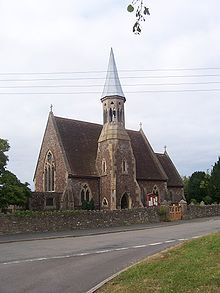Falfield
| Falfield | |
|---|---|
Avon and Somerset | |
| Fire | Avon |
| Ambulance | South Western |
| UK Parliament | |
Falfield is a village, located near the northern border of the
There are approximately 200 houses in the village with a population of some 500, increasing to 762 at the
The nearest town to the village is
Falfield is clustered mainly along the A38 road. It is also the first stop from Junction 14 of the M5. The shape of the parish is long in its length and narrow in its width. Both the A38 and M5 run through the village from north to south. It has a large garden centre, and two prisons (Eastwood Park and Leyhill) nearby. The village also includes St George's Church, The Huntsman Inn, a village hall, a small shop, a car dealership and several farms as well as 1st Falfield Scout Association who celebrated their 40th anniversary in 2013 and 1st Falfield & Stone Brownies part of Girlguiding who celebrated their 20th anniversary in 2016.[citation needed]
Falfield St George's Church is famous for being the burial place of Conservative politician Sir George Jenkinson, who died in 1892.[citation needed]
Politically, Falfield comes under the constituency of Thornbury & Yate, which is currently a Conservative Party seat held by Luke Hall.[citation needed]
Sport
Falfield was once home to successful

History
A
Anciently a settlement called "Mars" was associated with Falfield. However it has not been determined where this settlement existed, despite research.
A large part of the village is Eastwood Park, anciently a deer park belonging to Thornbury Castle in the 16th century. Later names associated with owners of Eastwood were Tyndale, Ashfield, Rogers, Jenkinson and Watts. More recently it came into the ownership of the Ministry of Defence followed by the Department of Health and is now run as a Conference and Training Centre.
Other older constructions in the village are: Green Farm whose origins are
A women's prison, HM Prison Eastwood Park, is located in the Falfield area.
The village appears to lack a manor house, possibly Heneage Court could have been such, but little of its history is known. Cannonballs found in the roof suggest its existence in the 16th century. Names connected with Heneage Court are: Skey, Hale, Montague Williams and Russell Thomas. Edward Warren laid out the gardens, pleasure grounds and woodland for Russell Thomas in 1913.
References
- ^ "Parish population 2011. Retrieved 19 March 2015". Archived from the original on 2 April 2015.
- ISBN 978-0-90438-749-0
